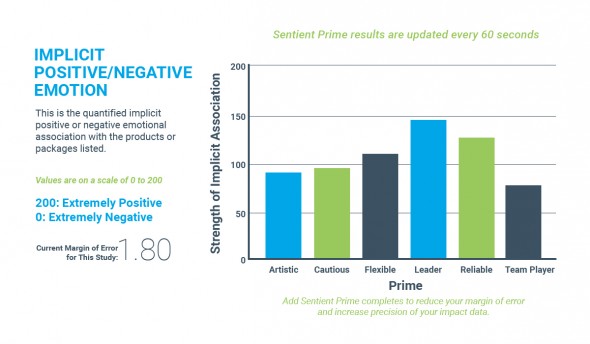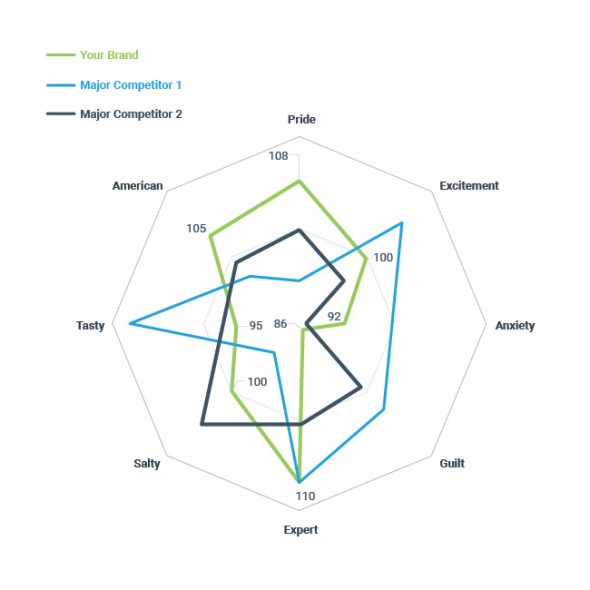How to Analyze Implicit Association Test Data: Quantifying the Consumer Subconscious
I want to provide some details on how to interpret data from Sentient Prime, along with a few tips and a case study showing some past results. These details are meant to get you thinking about how to best put this data to use for your clients and/or your business.
Getting Down To Basics
As with any research project, I’ll start with the design. The initial set up of a Sentient Prime project is straightforward. After selecting one of the available domains in our Software as a Service (SaaS) platform:
- Brand positioning/tracking
- Package testing
- Concept testing
- Ad testing
You’ll be provided with simple prompts to build your study. This includes the selection of attribute or emotional associations you want to test with your brand, package, concept or ad; followed by instructions for deployment and fielding.
Turning Data Points Into Quantitative Assessments of Implicit Attitudes
Once you have collected a minimum of n=200¹ (per segment) through your study, you are ready to export your data!
Our proprietary implicit association testing platform, Sentient Prime, automatically integrates the multiple implicit response data inputs collected by the technology to derive the quantitative assessment of implicit attitudes. We’re talking response time, accuracy, and more.
The “Index Score” Calculates Implicit Emotional Associations
This final output is provided as an “index score.” This value represents the non-conscious association between the tested brands/concepts/creative/packages and the tested emotions/attributes.
Values range from 0 to 200 and are provided at the individual level, meaning there is a value for each association for each respondent. These values work just like data from a standard Likert scale–think a ‘1-to-7 scale’ or ‘0-to-10 scale,’ but with much more detail in-between.

How to Know What’s Statistically Significant
Want to know what’s statistically significant? Statistical tests can be performed on these index values similarly as with any other quantitative data. A confidence interval is provided by the Sentient Prime Results control panel automatically (look for ‘current margin of error for this study’).
Interpreting the Consumer Subconscious: A Mock Example
To better understand what a finalized Sentient Prime project looks like, here is some example data from a brand positioning study.

The index values represent the distinct implicit associations between each of the brands above and the labeled emotions and attributes.
In this example, “Your Brand” is scoring higher on pride and expert, moderate on excitement, and low (but not as low as competitors) on anxiety.
Competitive comparisons are also valuable: “Major Competitor 1” is also scoring high on expert, and is scoring much higher on tasty and excitement.
As true implicit “emotional associations,” these index values provide valuable differentiation of brand attitudes within the consumer subconscious. Their quantitative nature lends itself to further statistical techniques like t-tests or regression to identify statistically significant differences and/or relationships.
Implementations of Sentient Prime
The other products available through Sentient Prime are equally simple to analyze; comparing index values across brands, concepts, or packages, potentially split by demographic segments. Here are some examples of the many ways to use implicit associations:
- Evaluating discrete emotion and attribute associations for your brand and your competitor brands among customers and non-customers to identify the drivers of product adoption
- Looking at differences in attribute associations among your own loyal customers vs. fair-weather customers to predict attitudes that drive brand loyalty
- Identifying concepts that drive particular emotions or attributes found to be implicit drivers in prior brand positioning work
- “Picking a winner” among creative concepts, especially when explicit preference questions can’t or won’t otherwise differentiate
Visit sentientprime.com now to start your free trial!

¹ n=400 is preferred; higher sample sizes reduce the margin of error, allowing you to more precisely detect smaller effects.
